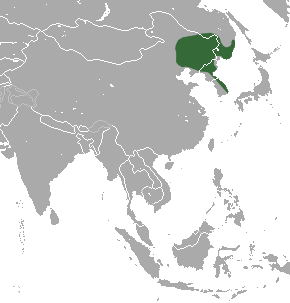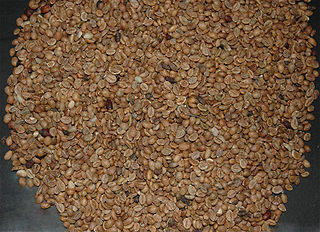
Coffea canephora, commonly known as robusta coffee, is a species of coffee that has its origins in central and western sub-Saharan Africa. It is a species of flowering plant in the Rubiaceae family. Though widely known as Coffea robusta, the plant is scientifically identified as Coffea canephora, which has two main varieties, robusta and nganda.

Washingtonia robusta is a palm tree native to western Sonora, and Baja California Sur in northwestern Mexico. It is reportedly naturalized in Florida, California, Hawaii, Texas, parts of the Canary Islands, Italy, Spain, and Réunion,

Grevillea robusta, commonly known as the southern silky oak, silk oak or silky oak, silver oak or Australian silver oak, is a flowering plant in the family Proteaceae. It is a tree, the largest species in its genus but is not closely related to the true oaks, Quercus. It is a native of eastern coastal Australia, growing in riverine, subtropical and dry rainforest environments.

Janenschia is a large herbivorous sauropod dinosaur from the Late Jurassic Tendaguru Formation of Tanzania, Africa, 155 million years ago.
Eonycteris is a genus of megabats found in Asia. Species within this genus are:

Eucalyptus robusta, commonly known as swamp mahogany or swamp messmate, is a tree native to eastern Australia. Growing in swampy or waterlogged soils, it is up to 30 m (98 ft) high with thick spongy reddish brown bark and dark green broad leaves, which help form a dense canopy. The white to cream flowers appear in autumn and winter. The leaves are commonly eaten by insects, and are a food item for the koala. It is an important winter-flowering species in eastern Australia, and has been planted extensively in many countries around the world. Its timber is used for firewood and in general construction.

The large mole or Ussuri mole, is a species of mammal in the family Talpidae. It is found in China, North Korea, South Korea, and Russia and lives in a long underground burrow, seldom emerging on the surface of the ground during the day.

The orange nectar bat is a species of bat in the family Phyllostomidae. It is found in Colombia, Costa Rica, Ecuador, Nicaragua, Panama, Peru, and Venezuela.

ROBUSTA is a nano-satellite scientific experiment developed by the University of Montpellier students as part of a Centre National d'Études Spatiales (CNES) call for student projects in the field of orbital systems.

The Philippine dawn bat,, is a species of megabat in the family Pteropodidae found in the Philippines.

Shorea robusta seed oil is an edible oil extracted from the seeds of Shorea robusta. Shorea robusta is known as the Sal tree in India. Sal is indigenous to India and occurs in two main regions separated by the Gangetic Plain, namely the northern and central Indian regions. The plant belongs to the Dipterocarpaceae botanical family.

Robusta coffee is coffee made from beans of the plant Coffea canephora, a sturdy species with low acidity and high bitterness. C. canephora beans, widely known by the synonym Coffea robusta, are used primarily in instant coffee, espresso, and as a filler in ground coffee blends.
Anastathes is a genus of longhorn beetles of the subfamily Lamiinae. As of 2018, it consists of the following species:
Anastathes biplagiata is a species of beetle in the family Cerambycidae. It was described by Gahan in 1901. It is known from Laos and Thailand.
Anastathes nigricornis is a species of beetle in the family Cerambycidae. It was described by Thomson in 1865. It is known from China, Malaysia, Java, Indonesia and Vietnam.
Anastathes parallela is a species of beetle in the family Cerambycidae. It was described by Breuning in 1956. It is known from China.
Anastathes parva is a species of beetle in the family Cerambycidae. It was described by Gressitt in 1935. It is known from China and Vietnam.

ROBUSTA-1B is a nano-satellite (Cubesat) scientific experiment developed by the University of Montpellier students, a successor to the ROBUSTA satellite, which was launched in February 2012 and lost soon after.
Kahawa Sūg, also known as Sulu coffee or Sulu robusta, is a single-origin coffee varietal grown by the Tausug people of the Sulu Archipelago, Philippines. It is a robusta cultivar, belonging to the species Coffea canephora. It originates from robusta plants introduced to Sulu in the 1860s. It is an important part of traditional Tausug culture. It is mostly consumed locally, though it has started being exported more widely in recent years. It is currently endangered by the introduction of modern higher yield coffee varieties.













